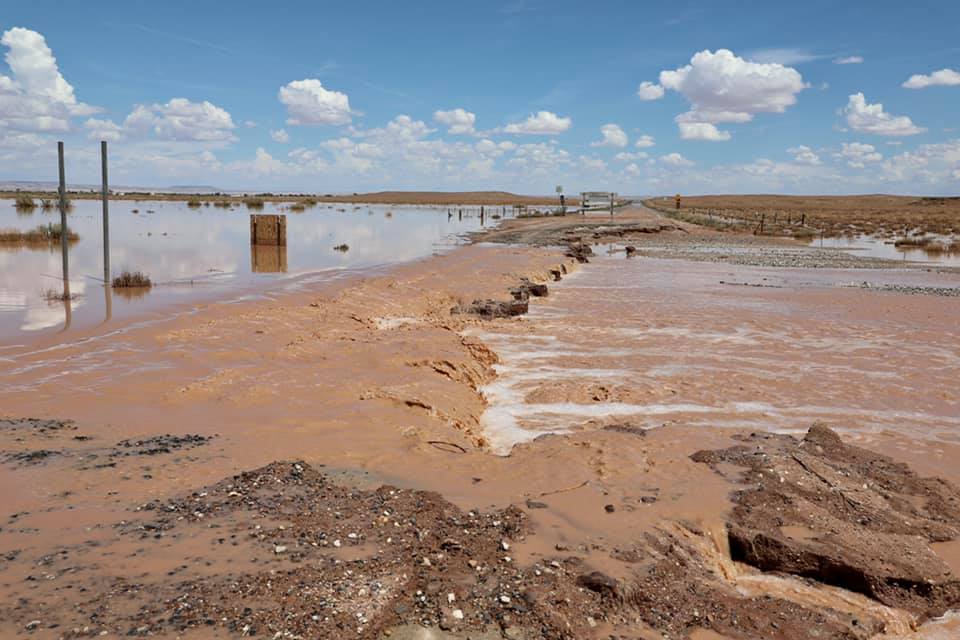
- Details
- By Native News Online Staff
WINDOW ROCK, Ariz. – The Navajo Nation Department of Emergency Management has issued a severe weather warning due to the forecast of heavy rainfall that is expected to begin on early Wednesday morning.
“The weather forecast shows heavy rainfall this week beginning on Wednesday morning in the western portion of the Navajo Nation and moving east throughout the day,” Navajo Nation President Jonathan Nez said. “Please be prepared, make sure your family and elders have essential items such as food, water, and firewood. Flash flooding can carry away people and vehicles if people enter flooded areas, so please be very cautious and do not enter flooded areas on foot or by vehicle.”
Want more Native News? Get the free daily newsletter today.
Parts of the Navajo Nation are still recovering from monsoon rainfall in July, according to Nez.
“The Navajo Division of Transportation’s work crews also continue to work on repairs to roads that were washed out in July,” Nez said.
Community Health Representatives, under the Navajo Department of Health, are also providing support and assistance for elderly residents and those with health conditions. The Navajo Division of Transportation will work as quickly as possible to clear roadways and repair roads in the event of more road washouts this week.
The following forecasts are provided by the National Weather Service for areas of the Navajo Nation:
- Tuesday, Aug. 31 - Scattered afternoon thunderstorms (50%), mainly near Window Rock and the Chuska Mountains.
- Wednesday, Sept. 1 - Thunderstorms will move from west to east early Wednesday morning through the afternoon hours. A flash flood watch (meaning ingredients are coming together) is in effect from 3am Wed through 6am Thu. Some of the heaviest thunderstorms can produce rainfall rates between 1 and 2 inches per hour. Lingering showers and thunderstorms will be possible after the heaviest rain passes.
- 3am - 6am: Heaviest rain developing over western Navajo Nation (Leupp, Tuba City, Tonalea, Kaibeto).
- 6am - 9am: Heaviest rain moving east into the Dilkon, Jeddito, Pinon, and Kayenta area.
- 9am - 12pm: Heaviest rain continuing to move east into the Ganado, Window Rock, Chinle, Tsaile area.
- 2 noon - 3pm: Heaviest rain continuing to move east into the Gallup, Newcomb, and Shiprock area.
- 3pm through the late afternoon: Heaviest rain moving east into the Albuquerque, N.M. area.
- Thursday, Sept. 2 - Drying out. Isolated afternoon thunderstorms (20%), mainly near Window Rock and the Chuska Mountains.
- Friday, Sept. 3 - Continued drying. Isolated afternoon thunderstorms (20%), mainly near Window Rock and the Chuska Mountains.
- Saturday, Sept. 4 - Typical monsoon day. A chance of afternoon thunderstorms (30%), mainly near Window Rock and the Chuska Mountains.
- Sunday, Sept. 5 - A little more moisture. A chance of afternoon thunderstorms (40%), mainly near Window Rock and the Chuska Mountains, and areas south of Highway 264.
- Monday, Sept. 6 - Typical monsoon day. A chance of afternoon thunderstorms (30%), mainly near Window Rock and the Chuska Mountains.
- Tuesday, Sept. 7 - Typical monsoon day. A chance of afternoon thunderstorms (30%), mainly near Window Rock and the Chuska Mountains.
Weather related information is available through the National Weather Service website at: https://www.weather.gov/.
More Stories Like This
Native News Weekly (August 25, 2024): D.C. BriefsUS Presidents in Their Own Words Concerning American Indians
NDAA passes House; Lumbee Fairness Act Advances
NFL, Vikings to Host Native All-American Game, Youth Flag Clinic
Senate Committee on Indian Affairs Passes 12 Bills to Strengthen Tribal Communities
Help us defend tribal sovereignty.
At Native News Online, our mission is rooted in telling the stories that strengthen sovereignty and uplift Indigenous voices — not just at year’s end, but every single day.
Because of your generosity last year, we were able to keep our reporters on the ground in tribal communities, at national gatherings and in the halls of Congress — covering the issues that matter most to Indian Country: sovereignty, culture, education, health and economic opportunity.
That support sustained us through a tough year in 2025. Now, as we look to the year ahead, we need your help right now to ensure warrior journalism remains strong — reporting that defends tribal sovereignty, amplifies Native truth, and holds power accountable.
 The stakes couldn't be higher. Your support keeps Native voices heard, Native stories told and Native sovereignty defended.
The stakes couldn't be higher. Your support keeps Native voices heard, Native stories told and Native sovereignty defended.
Stand with Warrior Journalism today.
Levi Rickert (Potawatomi), Editor & Publisher

